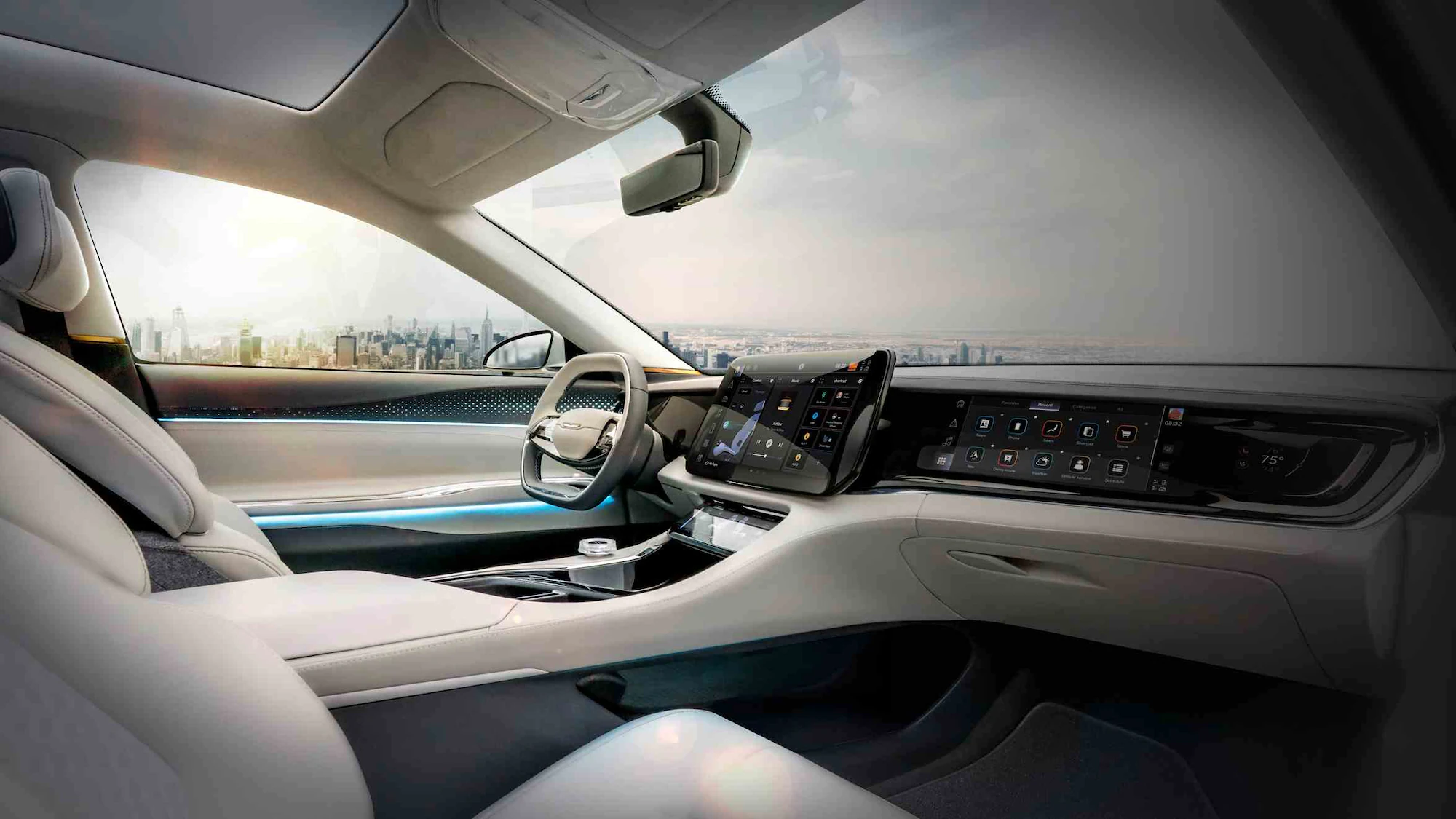Mehul Reuben DasMay 24, 2023 21:59:19 IST
Pros:
– Awesome performance in 1080P ultra settings
– Pretty decent performance in 1440P ultra settings
– Ports, especially DisplayPort 2.1
– Compact design, meaning can be fit into smaller cases
– AV1 support
– Price to performance. A true VFM GPU
Cons:
– 8GB VRAM and 128-Bit bus are adequate for now but will struggle in a few years
– Faces tough competition from previous-generation cards
– Lacks bling. No RGB
Rating: 4.25/5
Pricing: Rs 26,500
In the last couple of years, AMD has really made a case for itself that would force any casual gamer to take their GPUs seriously and a properly viable option. This is mainly down to three factors – NVIDIA, the people who would like you to believe that Moore’s law is dead (long live Moore’s Law!), has been all over the place with the pricing, as well as the performance of their RTX 3000 series and RTX 4000 series GPU. The 4000 series, particularly, has been very questionable.
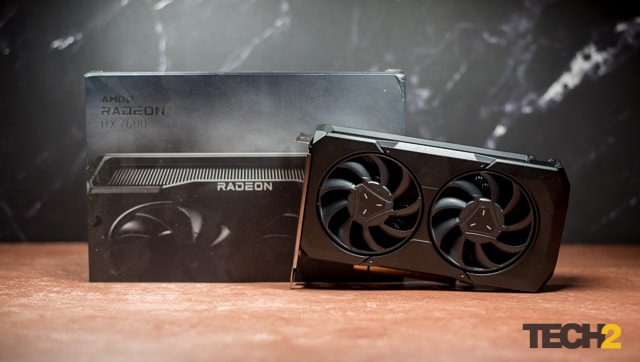
Second, Intel, despite designing a very good GPU has been haunted by its drivers since the day of their launch. Yes, over the months, their GPUs have become a force to be reckoned with, but the impression their cards gave at the time of the launch is hard to shake off.
And finally, and most importantly, AMD, for the last two to three generations of their CPUs, have been performing very solidly, especially when you consider the price-to-performance ratio. Sure, it may not have topped all benchmarks or gaming FPS charts, but the price that they came in, usually meant a difference of a few percentage points – something that’s barely noticeable in real-life applications.
The headlines that the RX 6600 made last year were largely positive because it was a damn good card, especially for its price back then. Today, the situation is different. GPUs are easily and readily available, and no matter how much they try, NVIDIA can’t gouge its customers as easily as it did last year.
AMD is positioning the RX 7600 as a 1080p gaming GPU, mainly because, as per Steam’s hardware survey, 65 per cent of gamers play at that resolution, with most of them using either a GeForce 1060 6GB or an RTX 2060 6GB. For such gamers, the RX 7600 with its RDNA 3 architecture, is supposed to be the perfect GPU to upgrade to. In such a scenario, is the RX 7600 worth it?
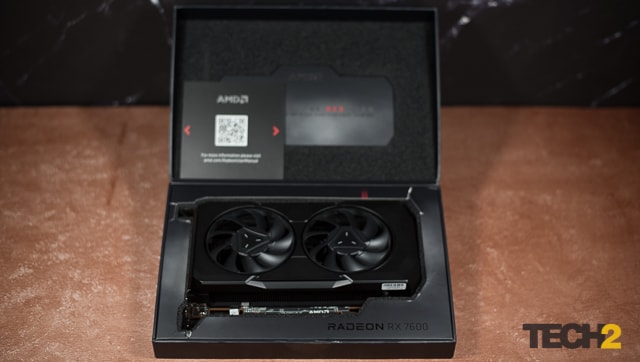
AMD Radeon RX 7600 GPU Review: Specifications and Features
The Radeon RX 7600 is built on AMD’s RDNA 3 architecture and is produced using TSMC’s 6nm manufacturing process. It features 128 Texture Mapping Units, 64 Raster Operation Processors, and 32 Ray Tracing units. With 2,048 Streaming Processors, it operates at a base clock speed of 2,250MHz and can boost up to 2,625MHz. The GPU is equipped with 8GB of GDDR6 memory and a 128-bit memory interface, providing a maximum bandwidth of up to 476.9 GB/s thanks to AMD Infinity Cache.
To connect to your PC, it utilizes a PCIe Gen 4.0 X8 slot. According to AMD, the GPU has a power draw of 165W TBP (total board power), requiring a 1X8-pin connector. However, a 550W power supply is sufficient to fully utilize the GPU’s capabilities, so there is no need to upgrade your power supply unit.
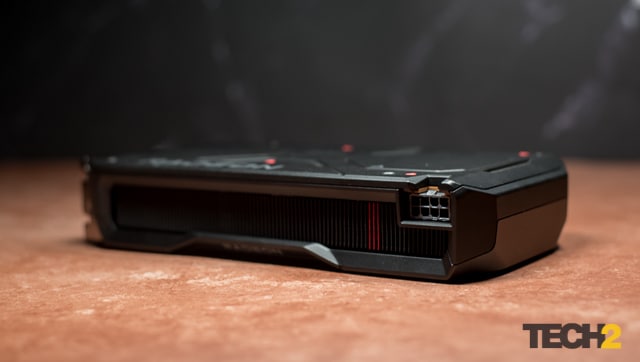
Design-wise, the Radeon RX 7600 is a simplistic card – it has no RGB lighting of any sort, but the reference card that we tested had a rather cool-looking backplate. There are two fans with 9 blades each with integrated rims, which are 78mm in diameter. The whole GPU itself is about 8-inches in length. The GPU occupies up to full-length slots on your typical chassis. What this means is that the card isn’t as thick as some of the latest offerings from NVIDIA, and can actually be used in compact builds as well.
While the 128-bit bus may seem narrow, AMD is able to not only remedy this but improve efficiency and performance, by using the 2nd Generation AMD Infinity Cache which has been increased. This cache level brings a new approach to data delivery in GPUs. The cache hierarchy has been carefully optimized to strike the right balance between Infinity Cache and L2 cache, ensuring optimal performance and efficiency.
The 2nd Generation AMD Infinity Cache serves as a global cache, providing fast access to data and acting as a powerful bandwidth amplifier. It enhances the GPU’s performance by delivering high-performance bandwidth while maintaining superb power efficiency. This innovative cache design significantly contributes to the overall efficiency and capabilities of the RDNA 3 architecture.
The Radeon RX 7600 has the usual three DisplayPort 2.1 UHBR13.5 ports and a single HDMI 2.1 port. This is one area where AMD’s latest generation hardware exceeds Nvidia’s Ada design, which still uses DisplayPort 1.4a.
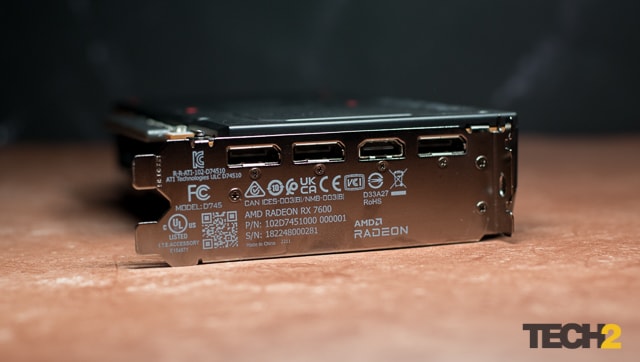
AMD has designed the Radeon RX 7600 with a particular focus on streamers. That is why you get support for hardware-accelerated media like AV1, HEVC, H.264, VP9 etc.
The RX 7600 also has a bunch of features that make gameplay very smooth, thus making the GPU very appealing. For example, we have FSR 2.0, or AMD FidelityFX Super Resolution 2, the latest iteration of AMD’s open-source spatial upscaling technology. This innovative technology is designed to enhance framerates and provide gamers with exceptional high-quality, high-resolution gaming experiences. Think of FSR 2.0 as a magic sauce that AMD applies on your games that make them run buttery smooth, crisp and tack sharp.
In addition, AMD’s Radeon Super Resolution (RSR) utilizes the power of AMD FidelityFX Super Resolution (FSR) 1 spatial upscaling within the driver. This feature allows for enhanced performance in thousands of games, completely free of charge. RSR can be enabled globally or on a per-game basis, giving users flexibility in their settings.
When enabled, a slider becomes available, offering further customization options to adjust the sharpness effect of Radeon Super Resolution. A display box will indicate whether RSR is active or inactive, along with the resolution that has been upscaled. To provide an example, if you have a 1440p monitor and you lower your game’s resolution to 1920×1080, RSR will upscale the 1080p resolution to match 1440p.
We have previously discussed the RX 7600’s SAM (Smart Access Memory) feature. SAM allows the GPU to communicate directly with the CPU, enabling the spillage of frames from the VRAM to the system RAM when the VRAM becomes filled. In simple terms, Smart Access Memory (SAM) is an optimization technique that enhances the processor’s access to a graphics card’s VRAM memory.
This enables the CPU to efficiently transfer a large amount of data to the GPU and offload its graphics calculations. As a result, the GPU can generate frames at a much faster rate, significantly reducing the time required for frame generation. In essence, SAM improves the collaboration between the CPU and GPU, resulting in faster graphics rendering and a smoother overall gaming experience. Do note that SAM or ReBAR is available on recent CPUs only. For Intel, you need 11th Gen CPUs or later, and for AMD, Ryzen 5000 Series CPUs and newer, along with 400 Series motherboards or newer.

Additionally, AMD SmartAccess Video intelligently distributes decoding and encoding workloads across all available video engines. By utilizing the video compression engines on both the Ryzen processor and Radeon graphics, it optimizes the distribution of video-related tasks. This results in fewer dropped frames and an overall faster experience when it comes to video editing and transcoding.
The RX 7600 comes with hardware-level support for AV1 encoding and decoding, making it a compelling choice for streamers. AV1 offers significantly better image quality compared to H.264, while requiring only a fraction of the bitrate. As a result, video game streaming with AV1 encoding places much less strain on computing resources compared to the traditional H.264 standard. This feature allows streamers to deliver high-quality streams with reduced computational overhead, enhancing the streaming experience for both content creators and viewers.
AMD Radeon RX 7600 GPU Review: Our testing rig
We paired our test unit of Radeon RX 7600 GPU with an AMD 7900X, 32GB Kingston Fury (2X16) RAM rated at 6000 MT/s, all connected to an Aorus X670E Master motherboard from Gigabyte. Cooling the CPU was an AMD Wraith PRISM cooler. Powering everything was the CoolerMaster MWE 750W V2 80 plus bronze PSU.
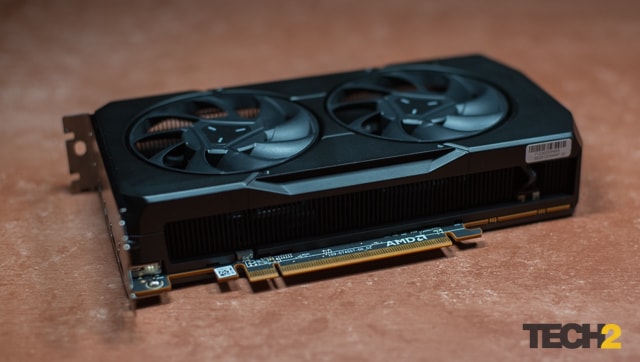
As always we did not overclock or change any settings before running our benchmarks and testing out games. The only change that we made was to enable EXPO so that our RAM operated at its rated speed and ensured that ReBAR or as AMD calls it Smart Access Memory, or SAM was enabled, which, AMD enables by default if you have a compatible motherboard and GPU. Other than this we ran everything on stock.
The reason why we checked if SAM was enabled is simple – although not all games benefit greatly by ReBAR or SAM, the ones that do, have 18-20 per cent more frame rates compared to systems that don’t have the option to enable SAM or ReBAR.
We ran the games at the highest possible settings whenever possible. We also had FSR 2.0 enabled in all the games that supported it. We also tested the games at 1440P.
AMD Radeon RX 7600 GPU Review: Performance
The Radeon RX 7600 is heading straight for the RTX 3060, without making any qualms. The RX 7600 simply crushes the best of RTX 3060s in practically almost every scenario, and that too while coming in at a considerably lower amount. In fact, in some scenarios, it performed almost as good as the RTX 3060Ti as well as the RTX 3070.
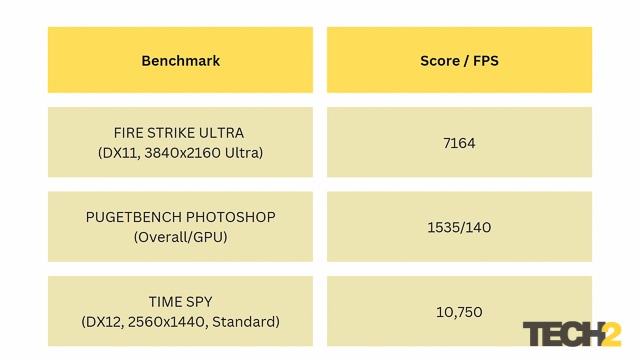
The 3DMark scores for the Radeon RX 7600 align with our expectations. It performs comparably to the RTX 3060, showing similar performance levels. However, in Furmark, the RX 7600 outperforms the competition by a significant margin. In terms of compute performance, LuxMark results are not in favour of the RX 7600, as it falls behind other cards. Nevertheless, its performance in Superposition remains highly competitive when compared to the aforementioned cards. Overall, the RX 7600 demonstrates strong performance in various benchmark tests, showcasing its capabilities in different scenarios.
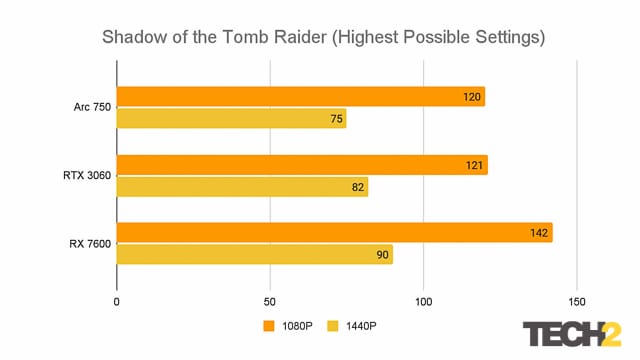
Indeed, the Radeon RX 7600 is well-suited for 1080p gaming, making it a reliable choice for that resolution. However, it doesn’t limit you to just 1080p gaming. Less demanding games will perform excellently at 1440p, and in certain cases, even 4K resolution is achievable. On the other hand, there may be extremely demanding games that struggle to run smoothly at 1080p with maximum settings. Nevertheless, in general, mainstream GPUs like the RX 7600 are typically considered ideal for 1080p gaming, offering a balance between performance and affordability.

What worries us, however, is the 8GB VRAM and 128-bit bus. Sure, it is good enough for most games today. And in certain games where the 8GB VRAM fell short – like in The Last Of Us bumping down the settings from Ultra surely does help.
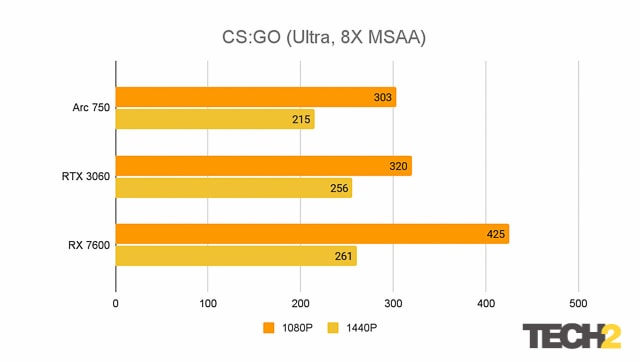
But consider this – game developers are spending less and less time on optimising their games for budget hardware. Moreover, in 2024 and 2025, we have games like GTA VI launching. We can only imagine what sort of texture packs are those going to bring, by the time they come to PC. While 8GB VRAM and 128-bit bus be adequate for now for 1080P ultra gaming, they won’t be nearly as adequate in a couple of years when games become more demanding, and people start moving towards 1440P and possibly even 2K or 4K.
AMD Radeon RX 7600 GPU Review: Conclusion
When considering whether to purchase the Radeon RX 7600 or explore options from NVIDIA or Intel, several factors come into play. Taking into account the price difference between the RX 7600 and even the basic RTX 3060 GPUs, we wholeheartedly recommend the RX 7600 for those building a new system specifically for 1080p gaming. Even at 1440p, the RX 7600 remains a sensible choice, especially when considering the Arc 750 from Intel.
However, if you’re planning to upgrade a GPU that is only a couple of years old or if your system is equipped with an older CPU (such as Intel’s 8th Generation or earlier, or an older AMD CPU), it may be more advantageous to explore other options.
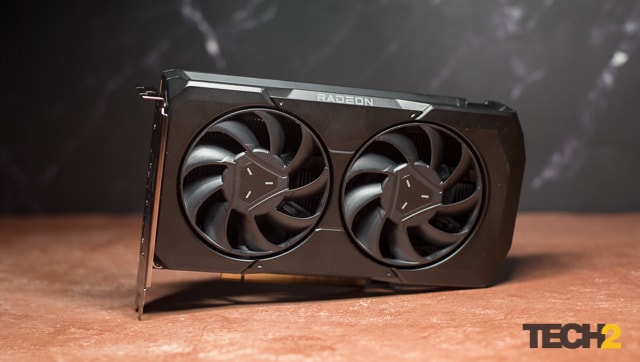
In terms of gaming performance, the RX 7600 performs almost as well as the RTX 3060 in most games and even outperforms it in some cases. If ray tracing is of utmost importance, even more so than higher frame rates, then opting for an RTX option may be preferable, albeit at a higher cost.
For 1080p gaming, the Radeon RX 7600 emerges as a strong contender and arguably the best option currently available. While the card may have some limitations, it surpasses many of its competitors and offers a more appealing price point.
While Nvidia’s offerings are a viable alternative, they come at a significantly higher cost, and the performance increase in most tests and games do not justify the extra expense. Therefore, if you prioritize a balance between performance and affordability for 1080p gaming, the Radeon RX 7600 is a compelling choice that delivers solid results without breaking the bank.
The RX 7600 boasts certain advantages over its NVIDIA counterparts, making it the preferred choice in many scenarios. For streamers and content creators, the Intel Arc 750 appears to be an ideal GPU option. Similarly, for those building, a budget-oriented editing and/or gaming PC, the RX 7600 remains a strong contender. Additionally, the support for AV1 video, although not immediately crucial, is a format that streamers and content creators who understand its benefits will likely transition to in the future.




